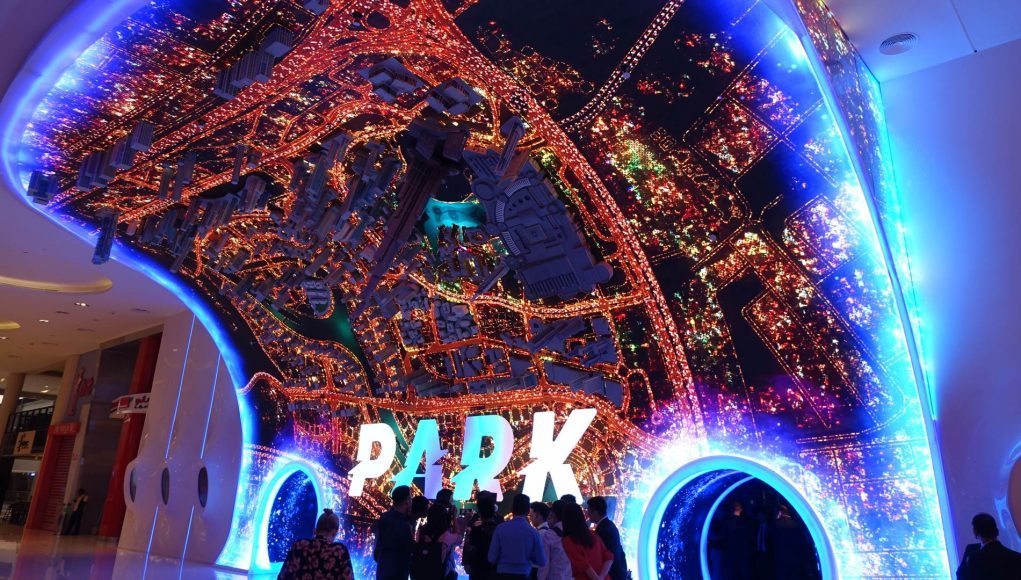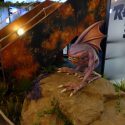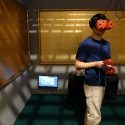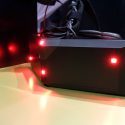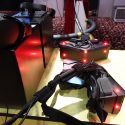Shared-space VR Co-op
The Raft is the newest game in the Starbreeze lineup; so new that the company admitted that it wasn’t originally planned for the park opening, but development was accelerated after some positive early testing. It will receive further polish in the future, but it is already fun to play. Surprisingly, it’s currently the only example of VR multiplayer in a shared tracking volume at the park; I expect this will become more prevalent in the future as it works so well in this type of venue (and means more customers using less space).
The action takes place on a raft which moves automatically through a swamp, in which increasingly dangerous supernatural creatures try to attack from all sides. Players can see and talk to each other in VR, and have to work together to protect the raft, switching between various mounted and handheld weapons, as well as using fire extinguishers to deal with this highly flammable mode of transport.

Unlike the StarVR experiences, the Vive hardware is ‘untethered’ through the use of backpack PCs, which is pretty important when you’re sharing a small space with three other players. The backpacks are powerful HP Omen X units, which Starbreeze say are capable of running the StarVR headset too. In the case of the multi-weapon action of The Raft, the team will need to come up with some creative ways of dealing with physical props if they upgrade the experience to StarVR.
Payday: The VR Heist is the second Vive-based co-op experience from Starbreeze, and gets its own themed ‘bank vault’ area, but unlike The Raft, each player is assigned a different room. Using a customised branch of the existing VR beta found in Payday 2, four players work together to raid a bank, while gunning down ever-increasing waves of law enforcement. It’s an entertaining romp, and offers the longest session time in the park at 15 minutes. With teleport locomotion and standard Vive hardware, it’s the most similar to a home VR setup out of Starbreeze’s current park attractions, so might not be first on the list for visitors already familiar with consumer-grade VR. But it’ll undoubtedly prove to be a hit for newcomers.
Roller Coaster Intensity
No theme park would be complete without a few physical rides, and these have been given UAE-themed VR makeovers by main developers Emaar Entertainment. The rides haven’t been created from scratch; VR Park is built on the site of The Dubai Mall’s previous indoor theme park called ‘SEGA Republic’, and like many other parks around the world that have introduced VR attractions, the physical rides have been repurposed for VR, and don’t feel totally cohesive as a result. The mobile Gear VR headsets aren’t able to provide the best VR quality in the first place, and there are limitations in what software creators can do to match existing motion cues with new visuals.
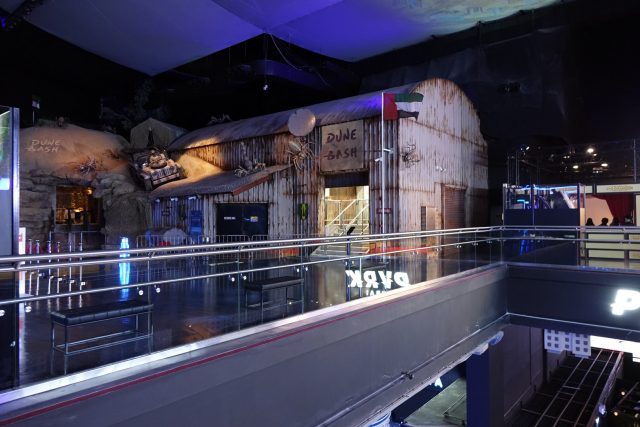
For example, Dune Bash is described as a “UAE desert 4WD experience” and takes place on a very powerful motion platform. In VR, it appears like you’re being given a wild passenger ride in an offroad vehicle of some kind, but the virtual ‘handling’ seems so bizarre that each simulated acceleration and change of direction is unpredictable and quite unpleasant.
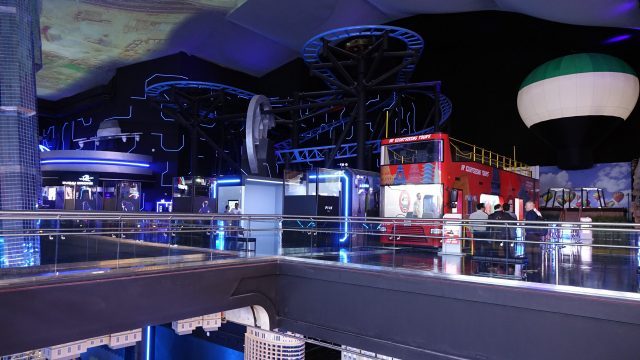
Dubai Drone on the other hand uses a proper, track-based roller coaster, so the accelerations and direction changes are very real. Being a fairly short track, the visuals need to set the scene and crescendo to a climax in an instant, and it’s all over rather too quickly. I’m glad it wasn’t longer to be honest; the visuals make it more difficult to anticipate the path of the coaster, so you can’t brace for the next turn in the same way you’d naturally do on a conventional ride. As a result, the g-forces feel more violent and intense, which might be enjoyable for some, but it just felt disconcerting to me, and the Gear VR with extra chin strap wasn’t really secure enough on my head to deal with the forces either.
The most compelling non-Starbreeze installation was Robocom VR, a spaceship combat sim using impressively responsive motion cockpits, but unfortunately marred by the performance of their custom VR headsets. With some tweaks, it could be one of the most enjoyable attractions at the park, as it was the only combat game that actually simulates a satisfying weapon recoil due to the seated cockpit design.
I’ve developed some decent ‘VR legs’ over the years, but the impact of the physical rides meant I was feeling rather queasy by the end. The VR Park is an assault on the senses, and mostly a positive one, but switching between multiple VR hardware solutions in quick succession (StarVR, Vive, Gear VR, and Robocom’s own headset) isn’t ideal.
StarVR Headset Leaves a Mixed Impression
This was my first time with StarVR, which is now at a mature stage of its ‘first gen’ LBE hardware deployment. The 5,120 × 1,440 resolution is a clear improvement over current consumer headsets, but with such a large FOV it could benefit from being higher still; I struggled to discern individual pixels, but could still make out a diagonal linen-like pattern (similar to the Rift but with finer lines) in bright scenes. The 210 degree horizontal FOV is an impressive glimpse into a magnificent ‘full human FOV’ future, but the almost ‘complete’ vision across the horizontal means that the limits of vertical FOV are more apparent, despite the fact that it is also better than any consumer headset in this specification too (about 130 degrees).
In motion, the StarVR’s output did not seem as smooth as consumer headsets, which is likely related to its 62Hz display, but also might be a case of inconsistent framerate or frame pacing in certain scenes. It felt solid enough, but I am sensitive to frame drops; these were subtle rather than immersion-breaking issues. The overall image could do with being brighter too; I imagine this is a limitation of applying low persistence to the current display technology (where, generally speaking, increasing the refresh rate improves brightness). It was effective however, with no noticeable smearing or ghosting, and I didn’t notice any flicker or strobing either, which was a pleasant surprise, considering how far the displays extend into your peripheral vision. In terms of a pure headset showcase, the short film Construct is the best way to enjoy the technology at the park, as its volumetric video rendering technique achieves the highest visual fidelity I’ve seen in VR.
StarVR’s optics is where I struggled the most. Perhaps it was my familiarity with the optical properties of consumer headsets, but StarVR’s giant lenses felt somewhat uncomfortable during the first couple of tries. There is no physical IPD dial, but the lenses are shaped in a way that compensates for a smaller or larger IPD depending on their vertical position relative to the eyes. I spent some time fiddling with vertical positioning which helped at little, but I never felt fully happy with the optics. There was a small but noticeable distortion across the horizontal plane, and it felt like my eyes were having to fight a slightly different ‘vergence conflict’ in the region of binocular overlap compared to what I’m used to in consumer headsets. By the last few sessions with StarVR, it did seem to be clicking with me a little more, so it might be more of a case of my eyesight requiring a period of internal recalibration to feel comfortable. These kind of issues should improve significantly with eye tracking technology, which is said to be in development for StarVR.
Where the park might be able to improve in the short term is moving more experiences to untethered backpack PC setups, or at least to better cable bungee solutions. For now, all the StarVR stations use a chunky cable connected to a hidden PC, and in experiences that promote a significant amount of movement like Ape-X, The Mummy Prodigium Strike and John Wick Chronicles, I was constantly aware of the suspended cable tugging at my head, which reduced immersion to some degree. The seated experience of The Walking Dead VR Outbreak meant that cable management wasn’t a problem.
Despite coming away with severe ‘FOV envy’, my personal presence level throughout the sessions was only occasionally higher than that of consumer headsets, and it’s difficult to say how much of these positive sensations were influenced by the physical props rather than the headset itself.

